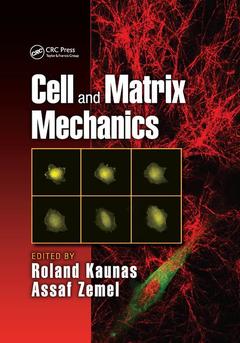Cell and Matrix Mechanics
Coordonnateurs : Kaunas Roland, Zemel Assaf

Explores a Range of Multiscale Biomechanics/Mechanobiology Concepts
Cell and Matrix Mechanicspresents cutting-edge research at the molecular, cellular, and tissue levels in the field of cell mechanics. This book involves key experts in the field, and covers crucial areas of cell and tissue mechanics, with an emphasis on the roles of mechanical forces in cell?matrix interactions. Providing material in each chapter that builds on the previous chapters, it effectively integrates length scales and contains, for each length scale, key experimental observations and corresponding quantitative theoretical models.
Summarizes the Three Hierarchical Levels of Cell Mechanics
The book contains 14 chapters and is organized into three sections. The first section focuses on the molecular level, the second section details mechanics at the cellular level, and the third section explores cellular mechanics at the tissue level. The authors offer a thorough description of the roles of mechanical forces in cell and tissue biology, and include specific examples. They incorporate descriptions of associated theoretical models, and provide the data and modeling framework needed for a multi-scale analysis. In addition, they highlight the pioneering studies in cell?matrix mechanics by Albert K. Harris.
The topics covered include:
- The passive and active mechanical properties of cytoskeletal polymers and associated motor proteins along with the behavior of polymer networks
- The mechanical properties of the cell membrane, with an emphasis on membrane protein activation caused by membrane forces
- The hierarchical organization of collagen fibrils, revealing that a delicate balance exists between specific and nonspecific interactions to result in a structure with semicrystalline order as well as loose associations
- The roles of matrix mechanical properties on cell adhesion and function along with different mechanical mechanisms of cell?cell interactions
- The effects of mechanical loading on cell cytoskeletal remodeling, summarizing various modeling approaches that explain possible mechanisms regulating the alignment of actin stress fibers in response to stretching
- The mechanical testing of cell-populated collagen matrices, along with theory relating the passive and active mechanical properties of the engineered tissues
- Cell migration behavior in 3-D matrices and in collective cell motility
- The role of mechanics in cartilage development
- The roles of both cellular and external forces on tissue morphogenesis
- The roles of mechanical forces on tumor growth and cancer metastasis
Cell and Matrix Mechanics succinctly and systematically explains the roles of mechanical forces in cell?matrix biology. Practitioners and researchers in engineering and physics, as well as graduate students in biomedical engineering and mechanical engineering related to mechanobiology, can benefit from this work.
Active Mechanics of the Cytoskeleton. Mechanobiology of the Cell Membrane. Cellular Reconstitution of Actively Self-Organizing Systems. Structural and Dynamical Hierarchy of Fibrillar Collagen. Cell–Matrix and Cell–Cell Mechanical Interactions. Dynamic Stress Fiber Reorganization on Stretched Matrices. Mechanics of Cell-Seeded ECM Scaffolds. Cell Motility in 3D Matrices. Collective Cell Migration. Connective Tissue Development. Cellular Forces in Morphogenesis. Mechanics of Tissue Morphogenesis. Continuum Physics of Tumor Growth. Cell Force–Mediated Collagen Remodeling in Cancer Metastasis. Index.
Roland Kaunas is an associate professor of biomedical engineering and the director of the Cell Mechanobiology Laboratory at Texas A&M University. He earned his BS in chemical engineering at the University of Wisconsin, his MS in biomedical engineering at Northwestern University, and his PhD in bioengineering from the University of California, San Diego. He joined the faculty at Texas A&M in 2005. His research focuses on experimental and computational modeling of cell reorganization and mechanotransduction in response to matrix stretching, fluid shear stress mechanotransduction in sprouting angiogenesis, and the development of collagen-based scaffolds for adult stem cell delivery for osteoregenerative therapies.
Assaf Zemel
Date de parution : 04-2018
17.8x25.4 cm
Date de parution : 11-2014
Ouvrage de 500 p.
17.8x25.4 cm
Thèmes de Cell and Matrix Mechanics :
Mots-clés :
Cancer Stem Cells; ECM Rigidity; Active Mechanics of the Cytoskeleton; Collective Cell Motility; Cellular Reconstitution of Actively Self-Organizing Systems; Single Cell Motility; Dynamic Stress Fiber Reorganization on Stretched Matrices; Actin Laments; Cell Motility in Three-Dimensional Matrices; Branched Actin Network; Cell Force-Mediated Collagen Remodeling in Cancer Metastasis; Myosin II; Actin Cytoskeleton; Actin Polymerization; Actin Stress Fibers; Cell Wedging; Ameboid Migration; Cell Membrane; Myosin; Cytoskeleton; Actin Networks; Cytoskeletal Mechanics; Traction Force; Cytoskeletal Remodeling; Focal Adhesion; Active Mechanics; MMP Cleavage Site; Mechanobiology; Tissue Construct; Myosin Motors; Collective Cell Migration; Stiffness Sensing; Amoeboid Migration; Multiscale Mechanobiology; Hydrophobic Mismatch; Embryogenesis; Actin Related Protein; Actively Self-Organizing Systems; ARP; Fibrillar Collagen; Cytoskeletal Polymers; Cell–Cell Mechanical Interactions; ECM Scaffold; Stretched Matrices; Collagen Bers; Cell-Seeded ECM Scaffolds; Triple Helix; Cell Motility; Cell Migration; 3D Matrices; Connective Tissue Development; Morphogenesis; Continuum Physics of Tumor Growth; Cell Force; Mediated Collagen Remodeling; Cancer; Metastasis; Membrane Mechanics; Cytoskeletal Polymerization; Tissue Mechanics; Biomechanics; Mechanotransduction; Engineered Tissues; Cell Adaptation



